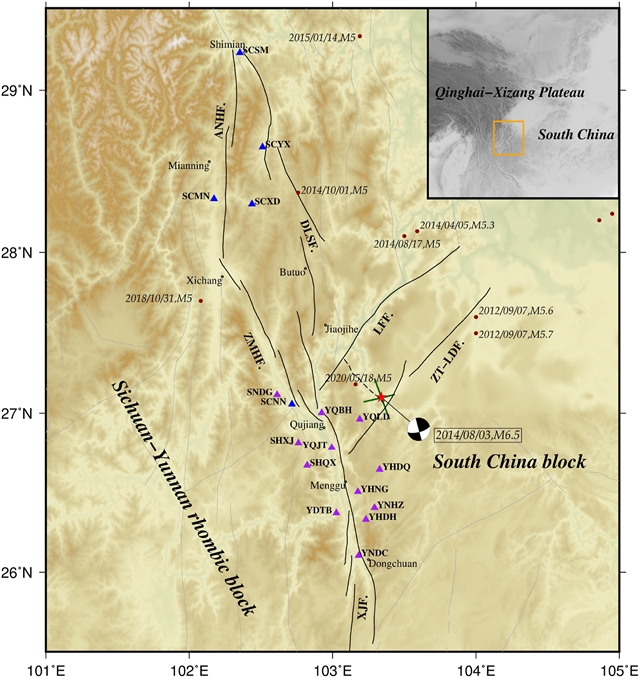
研究组利用全球导航卫星系统(GNSS)数据,研究了2014年6月22日发生在中国西南部鲁甸的6.8级地震的瞬态变形信号。在卡尔曼滤波框架内,采用一阶Gathems-Markov (FOGM)模型构建并隔离瞬态变形信号,提取FOGM时间序列。利用主成分分析(PCA)对提取的时间序列进行分解,分析东西向(EW)和南北向(NS)分量的前两个主成分(PCs)的时空演变,揭示其与鲁甸地震的相关性。此外,还定量分析了东向分量第二主分量(PC2)和南向分量第一主分量(PC1)的空间响应特征,表征了瞬态变形的空间演化模式。最后,将瞬态变形信号的空间分布与已知的同震破裂特征进行了比较,进一步证明了提取的信号代表的是真实的震后变形而不是噪声。
该研究的主要发现如下:1.东西向分量的PC2和南向分量的PC1主要代表鲁甸地震的震后瞬态变形信号。震后变形演化表现为地震发生至2016年初的持续变形阶段和2016年初开始的恢复阶段,反映了震后松弛过程的时变特征。2.除了众所周知的线性趋势分量和周期分量外,GNSS位移时间序列还可能包含非线性周期分量,这表明GNSS数据受到大气动力学、地表环境变化和人为因素的综合影响。3.将卡尔曼滤波和基于PCA的降维分析相结合,有效地将瞬态变形信号和非线性周期信号从复杂背景噪声中分离出来,提高了GNSS数据的可解释性。该方法为地震变形分析提供了一种高效的数据处理方法。
附:英文原文
Title: Extraction and identification of transient deformation after the Ludian earthquake
Author: Shangwu Song
Issue&Volume: 2025/10/15
Abstract: This study investigates the transient deformation signals associated with the Ludian M6.8 earthquake, which occurred on June 22, 2014, in southwestern China, using Global Navigation Satellite System (GNSS) data. Within the framework of the Kalman filter, the study employs a First-Order Gauss-Markov (FOGM) model to construct and isolate transient deformation signals, extracting the FOGM time series. Principal Component Analysis (PCA) is then applied to decompose the extracted time series and analyze the spatiotemporal evolution of the top two Principal Components (PCs) of the East-West (EW) and North-South (NS) components, revealing their correlation with the Ludian earthquake. Furthermore, a quantitative analysis of the spatial response characteristics of the second Principal Component (PC2) of the EW component and the first Principal Component (PC1) of the NS component is conducted to characterize the spatial evolution pattern of transient deformation. Finally, the spatial distribution of transient deformation signals is compared with the known co-seismic rupture characteristics, providing further evidence that the extracted signals represent real post-seismic deformation rather than noise. The key findings of this study are as follows: 1. The PC2 of the EW component and the PC1 of the NS component primarily represent post-seismic transient deformation signals associated with the Ludian earthquake. The post-seismic deformation evolution exhibits two distinct phases: a sustained deformation phase from the earthquake occurrence to early 2016 and a recovery phase starting from early 2016, reflecting the time-dependent characteristics of the post-seismic relaxation process. 2. In addition to the well-known linear trend and periodic components, the GNSS displacement time series may also contain non-linear periodic components, suggesting that GNSS data are influenced by a combination of crustal dynamics, surface environmental changes, and anthropogenic factors. 3. The integration of Kalman filtering and PCA-based dimensionality reduction analysis effectively isolates transient deformation signals and nonlinear periodic signals from complex background noise, enhancing the interpretability of GNSS data. This approach provides a highly efficient data processing method for analyzing earthquake-induced deformation.
DOI: 10.1016/j.geog.2025.08.003
Source: https://www.sciencedirect.com/science/article/pii/S1674984725000795
Geodesy and Geodynamics:《大地测量与地球动力学》,创刊于2010年。隶属于爱思唯尔出版集团,最新IF:2.4
官方网址:https://www.sciencedirect.com/journal/geodesy-and-geodynamics
投稿链接:https://www2.cloud.editorialmanager.com/geog/default2.aspx
